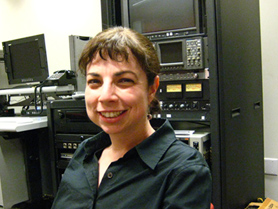
Carolyn Faber is the Media Collections Manager at the John M. Flaxman Library for the School of the Art Institute of Chicago (SAIC). Located in downtown Chicago, just a few blocks away from the Art Institute, Carolyn maintains a circulating collection of 16mm film prints, with access restricted to faculty and students. Carolyn had been a part of the field for several years after having studied filmmaking in college and working a variety of production jobs around the Chicago area before landing in a film archive. She has worked with film and moving image collections for 16 years due to her knowledge of 16mm film, including how to safely handle and repair it (meaning inspection, cleaning, and splicing), her familiarity with assessment and minor repair work of videotape, and her knowledge of digitization technologies and workflows. A few years ago, Carolyn decided to return to school for a master’s in Library Science. About this decision, she says, “It was mostly to expand on my existing skills and learn more about library environments – where I think some audio/visual collections can get kind of stuck in Special Collections ‘purgatory.’ But it was also practical – I wanted to get into higher-level jobs and saw that I was being passed over for lack of an advanced degree – I needed to be more competitive.”
At SAIC, Carolyn’s role is to keep fragile and damaged film prints in projectable condition, a tough job as commercial support for 16mm film continues to erode, she says. Replacing films with better quality projections can only be done once or twice a year, if at all, due to the challenge of cost and availability. When it comes to projecting the film, Carolyn has students and faculty trained and authorized by the Technical Managers in the Film, Video, New Media, and Animation (FVNMA) department’s certification program. The school also has numerous projectors available in several classrooms, but the main building where much of the requests come from has a media center available for students and faculty to check out projectors for viewings in empty classrooms – equipment never leaves the building; only the film cans travel. In the library, the film collection is kept on a separate floor from the book collection, on top of storage shelves in the staff work area. Lining the perimeter are several library staff offices, including Carolyn’s. Inside her office, Carolyn has a desk, film projector, screen, film inspection bench, various video decks, and a monitor. Every film is inspected before going out in circulation. Up until this past August, Carolyn’s job was primarily a part-time student-worker position. With her role expanding, the position has been bumped to a full-time management job with one student assistant working eight to ten hours a week. Thanks to her assistant, Carolyn has been able to catalog the backlog of DVDs in the library’s collection, assess the 16mm film collection, work more closely with the media held in special collections, and foster relationships with frequent users of the collections, like the FVNMA department. Her assistant, meanwhile, handles the film print inspections and projection request schedule. Assessing the collection has been important for determining short- and long-term goals. About developing the collection, Carolyn says, “Space is at a premium so we have to consider acquisitions very carefully. I do handle purchasing of new prints but as to the curatorial aspect of developing the collection – that is done in collaboration with senior staff.”

Even though Carolyn and her assistant do all of the conservation work, she says there is not much more they can do to prevent damage from happening each time a film is checked out. Carolyn believes creating access to the collection for use in teaching includes keeping some damaged prints for use in preservation, media genealogies, and material studies classes. About the collection, Carolyn says, “Many prints in the collection have been so battered from their years in circulation that all we can do is make sure they project without breaking.” While she has all of the typical tools of a film archivist – a shrinkage gauge, splicer, film cleaner and cloths, Moviscope viewer, perfix tape, and white gloves – work is not extensive on the films due to time and the possibility of better prints being available elsewhere. When a print is red, she will tell the instructor and “nine out of ten times they won’t show it.” These are cases when Carolyn has to borrow from other collections, like Canyon Cinema, to maintain access. With the intent to make the most of the film collection at SAIC, Carolyn plans to conduct an overall evaluation of the collection to determine which prints the library could consider replacing, if they are in fact replaceable, and which newer 16mm film works they can consider purchasing and entering into the circulation collection, all in the name of access.
~Erin McCall
Leave a Reply